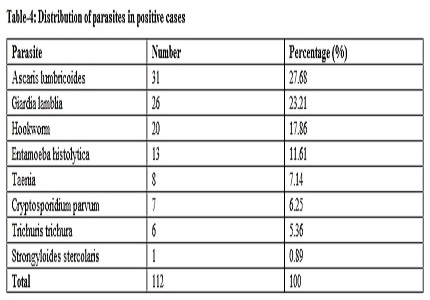Parasitic infestations in pediatric patients
Abstract
Introduction: Parasitic infestation is the important cause of morbidity in children. It is regarded as serious public health problem as it may cause anaemia, growth retardation and abdominal symptoms.
Objectives: 1) To study the occurrence of parasitic infestation in pediatric patients at KVG Medical College, Sullia. 2) To study the age and sex wise distribution of parasitic infestation in above patients.
Material and methods: After obtaining IEC approval, patients were recruited from department of Pediatrics at KVG Medical College, Sullia. Informed consent from the patients/legal guardian or assent from the child aged over 7 years was obtained. Stool samples were collected and were subjected to saline and iodine mount.
Results: Out of total 580 samples collected, 112(19.31%) cases were positive for parasitic infection. 5-10 years age group was most commonly affected (54.46%) and males (67.86%) were more affected as compared to females (32.14%). Ascaris was seen in 27.68% cases, G.lamblia was seen in 23.21% cases and was most common protozoal parasite. Hookworm was seen in 17.86% cases, E.histolytica in 11.61% cases. S. stercolaris, C.parvum and Taenia was seen only in few cases.
Conclusion: Ascaris, Giardia and hookworms were the predominant intestinal parasites in our study. Proper hygiene should be maintained as they can be transferred through soil.
Downloads
References
2. Asaolu SO, Ofoezie IE. The role of health education and sanitation in the control of helminth infections. Acta Trop. 2003 May;86(2-3):283-94. [PubMed]
3. Evans AC, Stephenson LS. Not by drugs alone: the fight against parasitic helminths. World Health Forum. 1995;16(3):258-61. [PubMed]
4. World Health Report, Conquering Suffering enriching humanity. World Health Organisation 1997-2000. Available at: http://www.who.int/whr/2000/en/
5. Bishnu Raj Tiwari, Ranju Chaudhary, Nabaraj Adhikari, Sailesh Kumar Jayaswal, Thakur Prasad Poudel, Komal Raj Rijal et al. Prevalence of Intestinal Parasitic Infections among School Children of Dadeldhura District, Nepal. JHAS, 2013;3(1):14-16.
6. Dr. Muzaffari Yasmeen, Shalini Singh. Study of the Prevalence of Intestinal Parasitic Infection in Children of Ghaziabad. Paripex - Indian Journal Of Research. Feb 2015;4(2):43-45.
7. Parija SC. Textbook of Medical Parasitology: Protozoology and Helminthology (4th edn.) All India Publishers and Distributors, New Delhi. 2015.
8. KD Chatterjee. Text book of parasitology protozoology and helmenthology, thirteenth edition.CBS publishers and distributers private limited. 2011;138-140.
9. Winning the fight against neglected tropical diseases. World Health Organisation 2006.
10. Boonchai Wongstitwilairoong, Apichai Srijan, Oralak Serichantalergs, Caroline D. Fakuda, Philip McDaniel, Ladaporn Bodhidatta et al. Intestinal parasitic infections among pre-school children in Sangkhlaburi, Thailand. Am. J. Trop. Med. Hyg. 2007;76(2): 345–350.
11. Haileeyesus Adamu , Tekola Endeshaw , Tilahun Teka , Achamyelesh Kifle , Beyene Petros. The prevalence of intestinal parasites in paediatric diarrhoeal and non-diarrhoeal patients in Addis Ababa hospitals, with special emphasis on opportunistic parasitic infections and with insight into the demographic and socio-economic factors. Ethiop.J.Health Dev. 2006;20(1):39-47.
12. Sneka P, Hanumanthappa A R, Vishwanath G. Prevalence of Parasitic Infections in Peadiatric Population – A Prospective Study International Journal of Scientific and Research Publications, March 2015;5(3).
13. Dr. Supriya Panda , Dr.U.Dharma Rao, Dr.K.Rama Sankara. Prevalence of Intestinal Parasitic Infections among School Children in Rural Area of Vizianagaram. IOSR Journal of Pharmacy and Biological Sciences (IOSR-JPBS). 2012;3(3):42-44.
14. Steven A. Miller, Carlos Luis Rosario, Elina Rojas and Jose Vicente Scorza. Intestinal parasitic infection and associated symptoms in children attending day care centres in Trujillo, Venezuela. Tropical Medicine and International Health. 2003; 8(4): 342-347.
15. K. Jayarani1, Sandhya Rani T1 and Jayaranjani K. Intestinal parasitic infections in pre-school and school going children from rural area in Puducherry. Current Research in Microbiology and Biotechnology.2014;2(4):406-409.
16. Geerts S, Gryseels B. Drug resistance in human helminths: current situation and lessons from livestock. Clin Microbiol Rev. 2000 Apr;13(2):207-22. [PubMed]
17. Meng XJ, Lindsay DS, Sriranganathan N. Wild boars as sources for infectious diseases in livestock and humans. Philosophical Transactions of the Royal Society B: Biological Sciences. 2009;364(1530):2697-2707. doi:10.1098/rstb.2009.0086. [Pub

Copyright (c) 2017 Author (s). Published by Siddharth Health Research and Social Welfare Society

This work is licensed under a Creative Commons Attribution 4.0 International License.


 OAI - Open Archives Initiative
OAI - Open Archives Initiative


